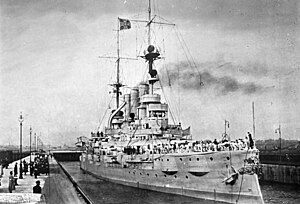 SMS Deutschland in the Kaiser Wilhelm Canal in 1912
| |
| History | |
|---|---|
| Name | Deutschland |
| Namesake | Germany (Deutschland in German) |
| Builder | Germaniawerft, Kiel |
| Laid down | 20 June 1903 |
| Launched | 19 November 1904 |
| Commissioned | 3 August 1906 |
| Decommissioned | 10 September 1917 |
| Stricken | 25 January 1920 |
| Fate | Sold for scrap in 1920 |
| General characteristics | |
| Class and type | Deutschland-class battleship |
| Displacement | |
| Length | 127.6 m (418 ft 8 in) |
| Beam | 22.2 m (72 ft 10 in) |
| Draft | 8.21 m (26 ft 11 in) |
| Installed power |
|
| Propulsion |
|
| Speed | 18 knots (33 km/h; 21 mph) |
| Range | 4,850 nmi (8,980 km; 5,580 mi) at 10 knots (19 km/h; 12 mph) |
| Complement |
|
| Armament |
|
| Armor |
|
SMS Deutschland (His Majesty's Ship Germany)[a] was the first of five Deutschland-class pre-dreadnought battleships built for the German Kaiserliche Marine (Imperial Navy). The ship was armed with a main battery of four 28 cm (11 in) guns in two twin turrets. She was built at the Germaniawerft shipyard in Kiel, where she was laid down in June 1903 and launched in November 1904. She was commissioned on 3 August 1906, a few months ahead of HMS Dreadnought. The latter, armed with ten large-caliber guns, was the first of a revolutionary new standard of "all-big-gun" battleships that rendered Deutschland and the rest of her class obsolete.
Deutschland served as the flagship of the High Seas Fleet until 1913, when she was transferred to II Battle Squadron. With the outbreak of World War I in July 1914, she and her sister ships were tasked with defending the mouth of the Elbe and the German Bight from possible British incursions. Deutschland and the other ships of II Battle Squadron participated in most of the large-scale fleet operations in the first two years of the war, culminating in the Battle of Jutland on 31 May – 1 June 1916. Late on the first day of the battle, Deutschland and the other pre-dreadnoughts briefly engaged several British battlecruisers before retreating.
After the battle, in which pre-dreadnoughts proved too vulnerable against more modern battleships, Deutschland and her three surviving sisters were assigned to coastal defense duties. By 1917, they had been withdrawn from combat service completely, disarmed, and tasked with auxiliary roles. Deutschland was used as a barracks ship in Wilhelmshaven until the end of the war. She was struck from the naval register on 25 January 1920, sold to ship breakers that year, and broken up for scrap by 1922.
Cite error: There are <ref group=lower-alpha> tags or {{efn}} templates on this page, but the references will not show without a {{reflist|group=lower-alpha}} template or {{notelist}} template (see the help page).